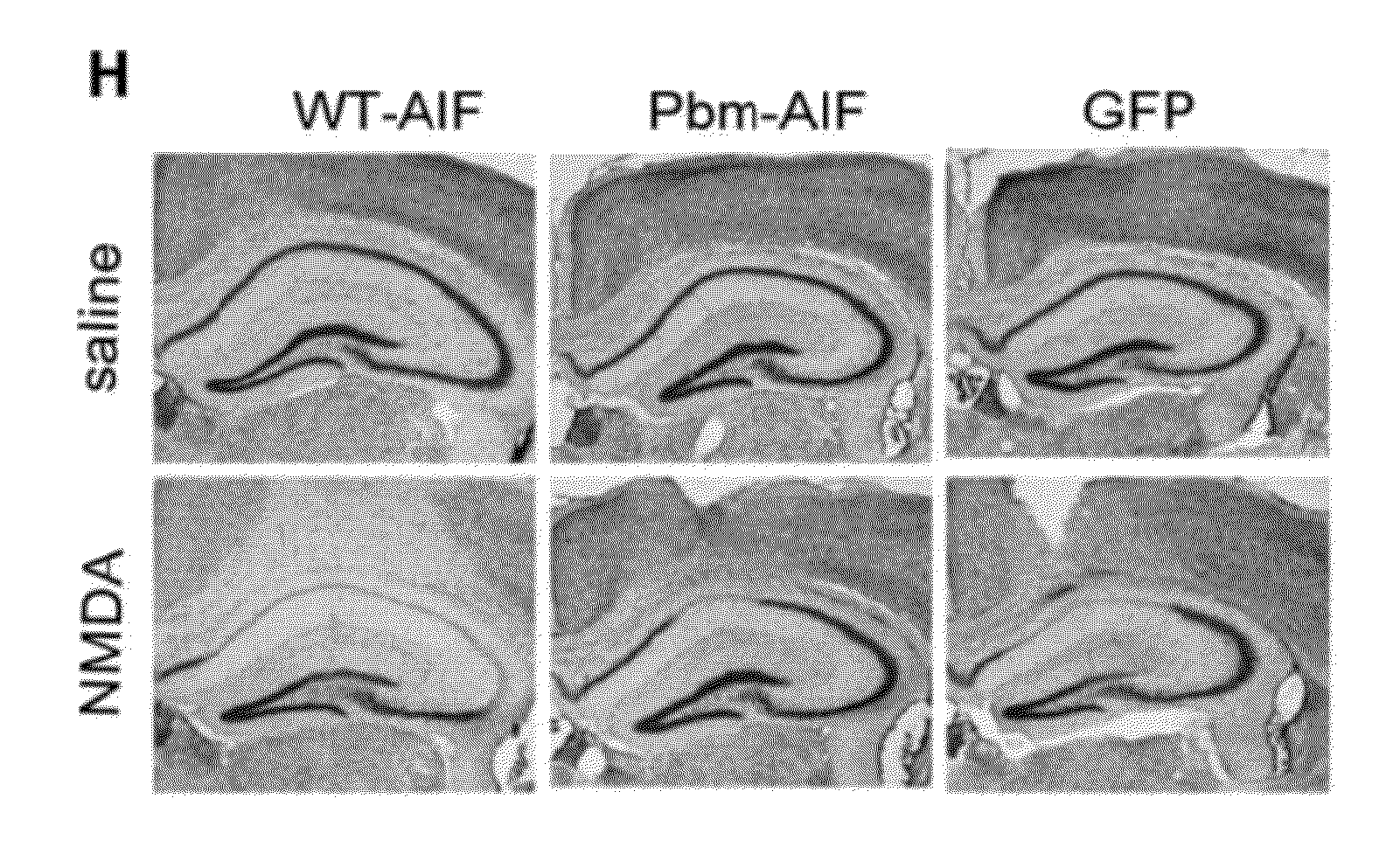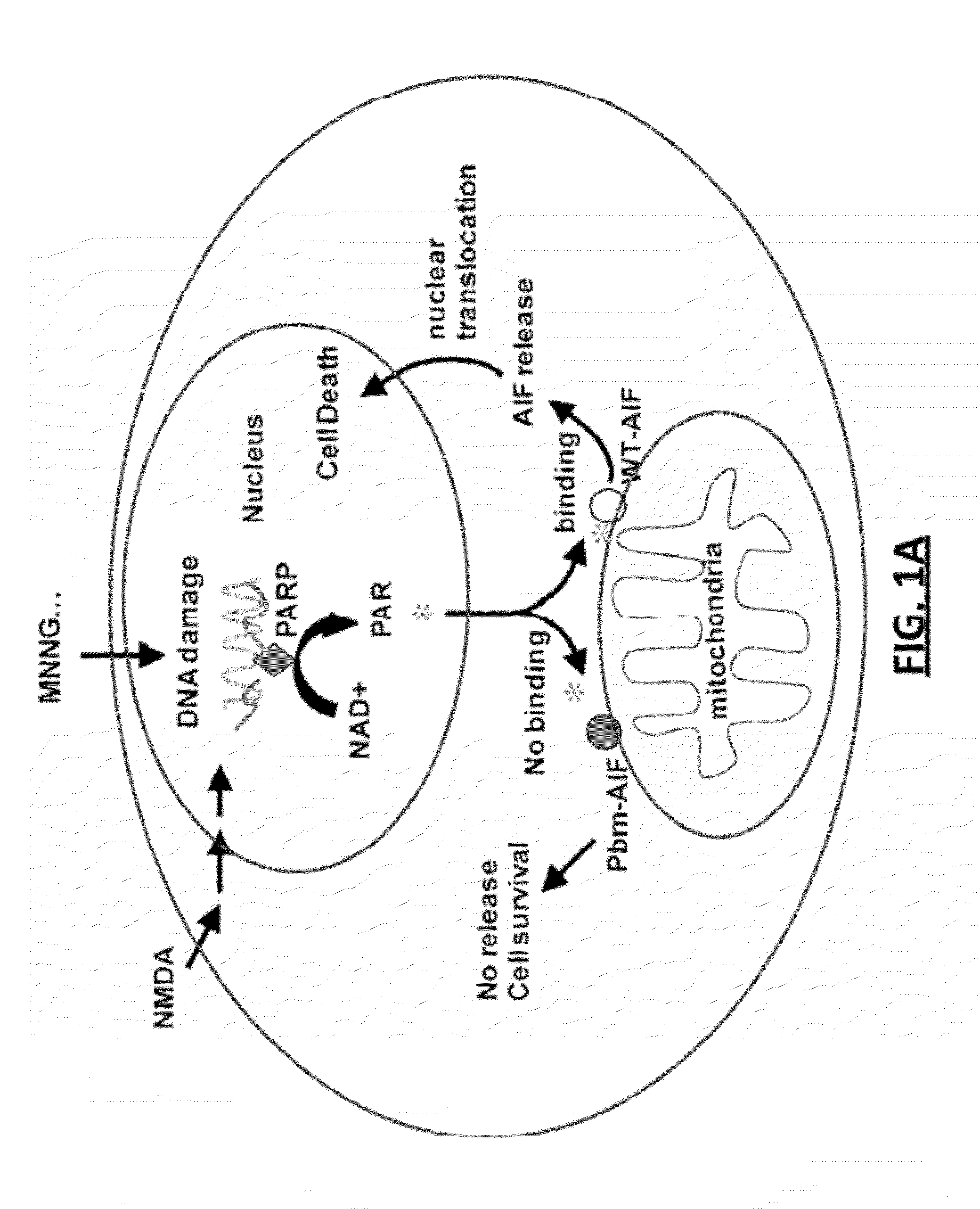Compounds and related methods for manipulating parp-1-dependent cell death
- Summary
- Abstract
- Description
- Claims
- Application Information
AI Technical Summary
Benefits of technology
Problems solved by technology
Method used
Image
Examples
example 1
[0075]The following experiment was performed to confirm whether AIF in fact binds to PAR. Applicants performed 3 trials of an overlay assay on recombinant AIF with affinity-purified biotin-labeled PAR. Histone H3, which binds to PAR with high affinity, was included as a positive control and bovine serum albumin (“BSA”) was included as a negative control, as described by P. Chang et al. (Nat Cell Bio, 2005). FIG. 1B depicts three photos side by side for gels representative of all trials for these overlay assays. As shown in FIG. 1B, AIF bound to biotin-labeled PAR in a concentration-dependent manner (see the increasingly darker bands from left to right in each gel at approximately 70 kDa under AIF). It can also be seen that PAR polymer bound with AIF in a similar pattern to histone H3, while BSA failed to bind with PAR polymer. Furthermore, to confirm this result, an electrophoretic mobility shift assay (“EMSA”) was performed for AIFm using 32P-labeled PAR and histone H1 as a positiv...
example 2
[0076]The following experiment was performed to confirm whether AIF in fact binds to PAR in intact cells. Applicants exposed HeLa cells stably transduced with lentivirus C-terminal Flag-tagged mouse wild type AIF (WT-AIF-Flag) to MNNG, a DNA alkylating agent that activates PARP-1 and kills cells primarily through parthanatos. PAR immunoprecipitation was performed from postnuclear fractions, which is the fraction prepared from whole cell lysates after removing nuclear proteins. FIG. 2A comprises two side by side black and white photos of representative gels obtained by Applicants, showing the impact of MNNG upon these HeLa cells (left photo being HeLa cells without MNNG, and right photo being HeLa cells 2 hours after MNNG treatment at 50 μM for 15 min). In the left gel of FIG. 2A, it can be seen that WT-AIF-Flag co-immunoprecipitated with PAR in resting cells. However, following MNNG treatment (the right photo of FIG. 2A), the interaction between AIF and PAR was significantly increas...
example 3
[0077]Next, to determine whether endogenous AIF interacts with PAR polymer, the interaction between endogenous PAR and AIF was explored in primary cortical neurons under both resting conditions and after NMDA glutamate receptor stimulation. This stimulation is known to activate PARP-1 potently and kill neurons through parthanatos. For this test, cortical neurons were homogenized and fractionated in CSS as described above, and FIG. 3A comprises a notated black and white photograph of a representative gel obtained from co-immunoprecipitation of endogenous AIF with PAR polymer is post nuclear fractions isolated from the cortical neurons 2 hours after NMDA treatment (500 μM for 5 minutes). Applicants found that endogenous AIF interacted with PAR in non-stimulated cortical neurons (see the first three columns of the gel photograph of FIG. 3A), but that interaction that was significantly increased following NMDA treatment (compare against the right three columns of the gel of FIG. 3A). FI...
PUM
| Property | Measurement | Unit |
|---|---|---|
| Cell death | aaaaa | aaaaa |
Abstract
Description
Claims
Application Information
 Login to View More
Login to View More - R&D
- Intellectual Property
- Life Sciences
- Materials
- Tech Scout
- Unparalleled Data Quality
- Higher Quality Content
- 60% Fewer Hallucinations
Browse by: Latest US Patents, China's latest patents, Technical Efficacy Thesaurus, Application Domain, Technology Topic, Popular Technical Reports.
© 2025 PatSnap. All rights reserved.Legal|Privacy policy|Modern Slavery Act Transparency Statement|Sitemap|About US| Contact US: help@patsnap.com



